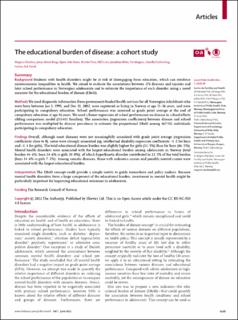| dc.contributor.author | Nordmo, Magnus | |
| dc.contributor.author | Kinge, Jonas Minet | |
| dc.contributor.author | Reme, Bjørn-Atle | |
| dc.contributor.author | Flatø, Martin | |
| dc.contributor.author | Suren, Pål | |
| dc.contributor.author | Wörn, Jonathan | |
| dc.contributor.author | Magnus, Per Minor | |
| dc.contributor.author | Stoltenberg, Camilla | |
| dc.contributor.author | Torvik, Fartein Ask | |
| dc.date.accessioned | 2022-08-03T12:42:22Z | |
| dc.date.available | 2022-08-03T12:42:22Z | |
| dc.date.created | 2022-07-18T14:33:22Z | |
| dc.date.issued | 2022 | |
| dc.identifier.issn | 2468-2667 | |
| dc.identifier.uri | https://hdl.handle.net/11250/3009982 | |
| dc.description.abstract | Background
Students with health disorders might be at risk of disengaging from education, which can reinforce socioeconomic inequalities in health. We aimed to evaluate the associations between 176 diseases and injuries and later school performance in Norwegian adolescents and to estimate the importance of each disorder using a novel measure for the educational burden of disease (EBoD).
Methods
We used diagnostic information from government-funded health services for all Norwegian inhabitants who were born between Jan 1, 1995, and Dec 31, 2002, were registered as living in Norway at age 11–16 years, and were participating in compulsory education. School performance was assessed as grade point average at the end of compulsory education at age 16 years. We used a linear regression of school performance on disease in a fixed-effects sibling comparison model (113 411 families). The association (regression coefficients) between disease and school performance was multiplied by disease prevalence to estimate the proportional EBoD among 467 412 individuals participating in compulsory education.
Findings
Overall, although most diseases were not meaningfully associated with grade point average (regression coefficients close to 0), some were strongly associated (eg, intellectual disability regression coefficients –1·2 for boys and –1·3 for girls). The total educational disease burden was slightly higher for girls (53·5%) than for boys (46·5%). Mental health disorders were associated with the largest educational burden among adolescents in Norway (total burden 44·6%; boys 24·6% vs girls 20·0%), of which hyperkinetic disorder contributed to 22·1% of the total burden (boys 14·6% vs girls 7·5%). Among somatic diseases, those with unknown causes and possibly mental causes were associated with the largest educational burden.
Interpretation
The EBoD concept could provide a simple metric to guide researchers and policy makers. Because mental health disorders form a large component of the educational burden, investment in mental health might be particularly important for improving educational outcomes in adolescents. | en_US |
| dc.language.iso | eng | en_US |
| dc.publisher | Elsevier | en_US |
| dc.rights | Attribution-NonCommercial-NoDerivatives 4.0 Internasjonal | * |
| dc.rights.uri | http://creativecommons.org/licenses/by-nc-nd/4.0/deed.no | * |
| dc.title | The educational burden of disease: a cohort study | en_US |
| dc.type | Journal article | en_US |
| dc.type | Peer reviewed | en_US |
| dc.description.version | publishedVersion | en_US |
| dc.rights.holder | Copyright 2022 The Author(s) | en_US |
| cristin.ispublished | true | |
| cristin.fulltext | original | |
| cristin.qualitycode | 1 | |
| dc.identifier.doi | 10.1016/S2468-2667(22)00059-7 | |
| dc.identifier.cristin | 2038668 | |
| dc.source.journal | The Lancet Public Health | en_US |
| dc.source.pagenumber | e549-e556 | en_US |
| dc.relation.project | Norges forskningsråd: 273659 | en_US |
| dc.relation.project | Norges forskningsråd: 300668 | en_US |
| dc.relation.project | Norges forskningsråd: 262700 | en_US |
| dc.identifier.citation | The Lancet Public Health. 2022, 7 (6), e549-e556. | en_US |
| dc.source.volume | 7 | en_US |
| dc.source.issue | 6 | en_US |

